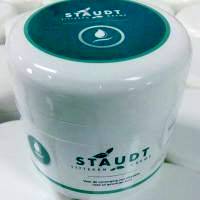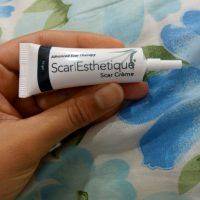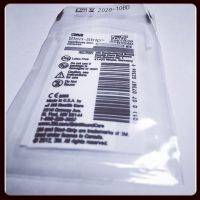Scar Treatment After Breast Reduction
There are a variety of over-the-counter products available for the treatment of scars.
The two mainstay therapies that have been proven to be effective are pressure dressings and silicone based ointments. Both kinds of treatments have been shown to improve scars.
I advise patients to use scar cream once the scar is well healed and stable, which is approximately 3 weeks after surgery. All scars improve in appearance with time. It can take a minimum of 6 months to one year for scars to fully fade.
If any scars are not significantly improved after 1 year, additional more involved treatments may be needed. Microneedling can stimulate collagen remodeling and can improve the appearance of scars after they have fully healed.
If the scar is dark and/or raised in appearance, injections with dilute steroids can improve them. (John Diaz, MD, Beverly Hills Plastic Surgeon)

BioCorneum For Scars
Silicone is great for scars as well. It helps to reduce the redness faster and flattens them. Many products are now available without prescription which contain silicone. (Ellen A. Janetzke, MD, Bloomfield Hills Plastic Surgeon)
Minimizing scars after breast reduction
The best way to have a good result is to see a board certified Plastic Surgeon who has good technique and good results. Sometimes scars heal in a way that is unpredictable. However, silicone scar sheeting can be used to help with scar healing as well as massage of the scars after surgery. (Thomas Guillot, MD, Baton Rouge Plastic Surgeon)

How Can I Minimize Scars From Bust Reduction Surgery
Always follow your surgeons guide lines as when to start your scar care, whether it be topical creams, or silicone sheets that you apply daily. Many surgeons say the act of massage is important on helping scars improve.
Always remember to wear sunscreen, exposure to sunlight can make scars have hyperpigmentation, 30 SPF and above, is recommended.
Follow up with your plastic surgeon to confirm that your scars are maturing as expected. (Al Cohn, MD, Birmingham Plastic Surgeon)
Scar minimisation in Breast Reduction Surgery
Scar treatment options include silicone based therapy either in the form of silicone tape or silicone scar gel.
You’ll need to be diligent, patient and consistent in its daily application at least for 3 to 6 months post op in order to achieve the most optimal outcome.
Appropriate scar massage can also assist in optimal healing and scarring but the intrinsic scar propensity is also determined by various underlying genetic factors as well as certain environmental influence. (Ellis Choy, FRACS(Plast), Sydney Plastic Surgeon)

Kelo-cote
Silicone and silicone products have the best evidence for minimizing scarring. There are many, many different formulations. Which you choose is likely less important than your willingness to use the product 24 hours a day, 7 days a week for a few months while the scars are healing.
When used appropriately, the end results can be dramatic. (Jeremy Pyle, MD, Raleigh-Durham Plastic Surgeon)
Best ways to minimize scars after breast reduction
A good supportive bra is effective because it prevents excessive tension, which can stimulate scar formation. The application of pressure to a scar is also effective. Patients can apply paper tape or use a silicone gel pad if more specific pressure is needed.
A scar takes approximately 6 months to a year to reach maturity, so be patient. (Wandra K. Miles, MD, Seattle Plastic Surgeon)

Scar Cream
BioCorneum for Scars
In my practice, our preferred product to help with a patient’s post-operative scarring is BioCorneum. We recommend that all of our patients use BioCorneum twice a day once their sutures have been removed and they have been cleared to begin use.
BioCorneum is a self-adhering advanced silicone treatment and contains SPF 30. Its use helps to minimize the appearance of scars and helps to protect these scars from the aggravating effects of the sun (hyperpigmentation). We carry BioCorneum in our office in two different sizes and recommend that patients use this for at least 6-12 months. (Stephen T. Greenberg, MD, Woodbury Plastic Surgeon)
Kelo-cote to minimize scars
I recommend Kelo-cote to all of my patients. It is a clear silicone cream that is put on the incision twice a day. This will help the scar flatten and fade more quickly. It can be used on new as well as old scars. (Jennifer Greer, MD, Cleveland Plastic Surgeon)

Scar Massage
Scar Gels
One thing that I have found to be particularly useful is growth factor based scar gels. They can really make a difference, but shouldn’t be applied typically until it has been one month from the surgery. (Gary Lawton, MD, FACS, San Antonio Plastic Surgeon)
Breast reduction scars: cause and management
In my opinion, scars are 50% the surgeon’s skills and 50% your response to an injury. Having said this silicone gel strips have some of the best science behind them but patients generally find it difficult to comply with at least 12 hours a day wear.
I have found that topical paper tape therapy works best for my patients and is easy to apply with minimal care. (Otto Joseph Placik, MD, Chicago Plastic Surgeon)
Reducing scars with breast reduction surgery

Scar Therapy
Silicon containing products might help reduce your final scar appearance
The final appearance of any scar that is a result of a surgical incision is not predictable. There are many factors that contribute to this appearance. Of course, the surgical technique used to suture the incision plays a significant role in the outcome.
However, the patients own genetic predisposition to healing with a more or less noticeable scar can override all other factors. Beyond employing good surgical technique there is not a “silver bullet” the surgeon can, figuratively speaking, shoot at the scar that will magically minimize it.

Scarguard
Later on surgical revisions employing certain laser techniques can be tried. (David A. Ross, MD (retired), Chicago Plastic Surgeon)
Minimizing scars after breast reduction
There are many methods which can help minimize your breast scars (and any other surgical scars for that matter). For years, I would typically use Steristrips on the scars for about 3 weeks, then change to a silicone based product like Scarguard, or silicone sheeting.
That method works well, but I have changed to following up the 3 weeks of Steristrips with paper tape instead. That’s right, just plain paper tape similar to what is used to keep the dressing on right after surgery.

An Expert Surgeon Can Minimize The Potential For Chest Reduction Scars
We know that tension across a wound can lead to bad scars. We also know that wound strength is still minimal at 3 weeks. Makes sense to me to use something that augments the strength of the healing wound for longer than 3 weeks.
I have been very pleased with the results. (Douglas J. Mackenzie, MD, Santa Barbara Plastic Surgeon)
Breast reduction scars
Breast reduction scars can take up to one year to fully mature and fade. You can apply silicone sheets/tape to the incision sites for several months to minimize the appearance of scars, as well as a topical gel form of silicone called Kelocote.

Minimizing Scars From A Bust Reduction – Surgical Technique Is Key
Problematic scars may also benefit from steroid injections which can be done in your surgeon’s office. Be diligent with these topical creams and be patient, you’ll be surprised how nicely the scars will soften and lighten as time goes by. (William Bruno, MD, Beverly Hills Plastic Surgeon)
After volume reduction of the breast, there will be a surplus of skin. To rid the excess, this skin needs to be excised. As a general rule, the more skin removed, the longer the incisions.
There are fudge factors plastic surgeons employ, but they help only to a certain extent. Probably more important than the length of the scars is the quality. This is where the skills of a good plastic surgeon can make all the difference. (Vincent N. Zubowicz, MD, Atlanta Plastic Surgeon)
Reduce your Breast Reduction scars
Years ago we did a controlled study with a laser that goes after the blood vessels in scars. We found significant improvement in sloftness, flatness and color by treating with the laser 1x per month for 6 treatments starting 30 days after surgery. (Barry E. DiBernardo, MD, Montclair Plastic Surgeon)The goal of everyone is to have no scars, but it is not possible if you have significant sag.
Liposuction of the breast will reduce the breast size and you can get some elevation of the nipple.
Most patients want smaller, perkier breast. This requires skin excision and thus scars. We try to close all breasts with no external sutures. We use long lasting PDS sutures so that the tension is reduced on the incision longer.
Massage of the scars with any lotion starting at 2 weeks and the use of topical silicone sheets or liquid – Scar fade also helps. Time is the most important element. It often takes 6 0 12 months to get the best results. (Richard Greco, MD, Savannah Plastic Surgeon)
Wait six months
As long as your scars are not wide they tend to get better. Just wait at least six months. If they are wide, revision is occasionally in order. Gel sheeting and massage can be helpful while you are waiting as long as they early healing has already occurred. (John P. Di Saia, MD, Orange Plastic Surgeon)
Minimizing scars after ANY surgery
Scar care is very important after any type of surgery. To minimize pigmentation issues with scars, sun avoidance is key, and sometimes bleaching creams are appropriate. For scar thickness issues, time is the main factor, but we can accelerate the maturation with the assistance of scar creams or silicone sheeting. (Michael A. Bogdan, MD, FACS, Dallas Plastic Surgeon)


I had breast reduction surgery a little over 4 weeks ago. On the drive home (over an hour away) I developed a hematoma in my left breast and my husband rushed over to our local hospital. I passed out and after being revived ands cleaned up, took an hour and a half hospital ride to another medical center to undergo another surgery. Needless to say, I’ve heard this is not typical.
2 weeks ago my other breast’s incision under the nipple seemed to open. There’s drainage that looks yellowish and thick. I went to a regularly scheduled follow up the morning I noticed this. They said it is fine. They suggested using maxi pads as dressing. Over that weekend, it bled whenever I pulled the dressing away. It looked awful, like an open wound. I called and my surgeon said to come in that day. Again, it’s an hour and a half away but better safe, right? He and the nurse said it was healing beautifully. He prescribed saline to put on gauze and taped on. It’s been a week and it still looks terrible, looks like it’s opened up more. It hurts to pull the gauze away and bleeds. Blood actually fell on my leg and tbe floor one time. I’m calling again today and honestly I’m beginning to not trust this place though it had great reviews and a friend had hers done there. Any suggestions or is this at all normal for some?
Definitely keep on top of this with a doctor. Even if you need to see your GP close to home. If you have yellow and smelly drainage, you may need antibiotics. Did he mention that at all?